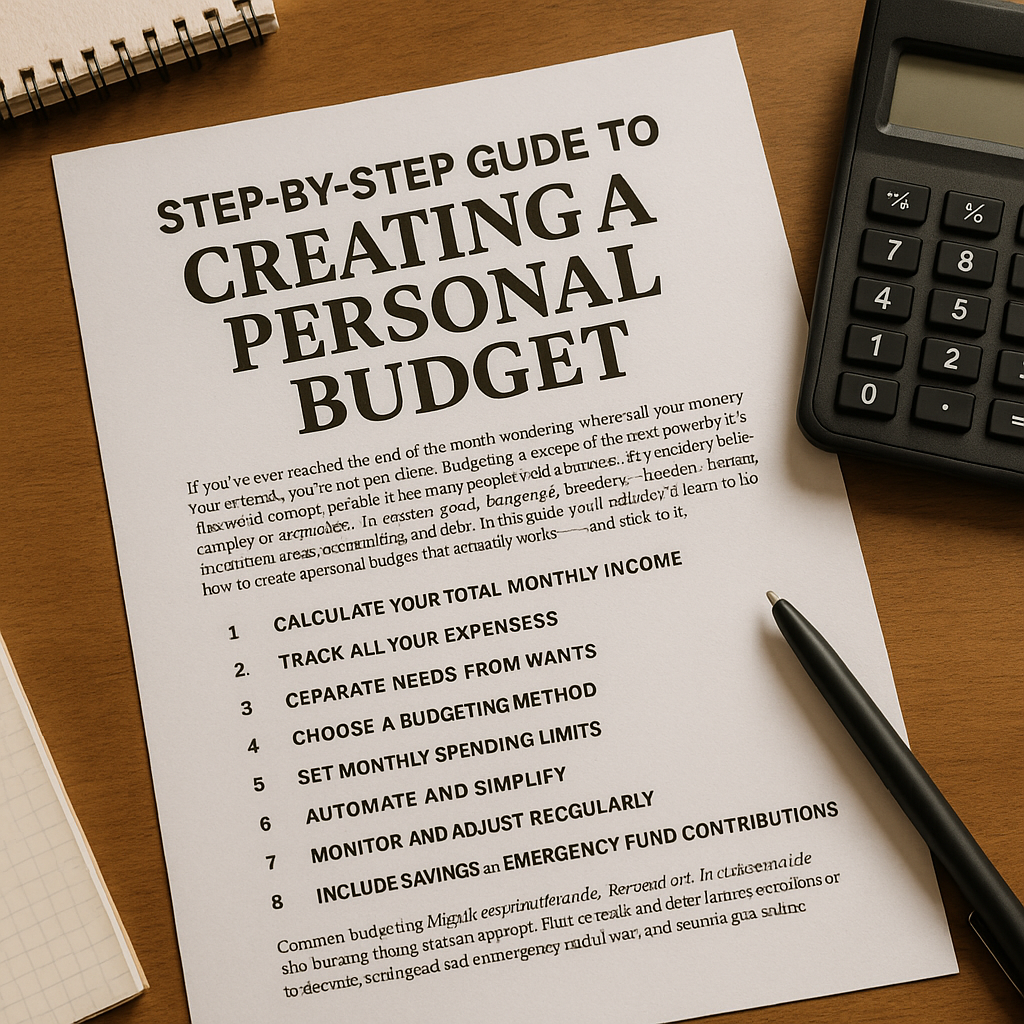If you’ve ever reached the end of the month wondering where all your money went, you’re not alone. Budgeting is one of the most powerful tools for financial control, yet many people avoid it because they believe it’s too complex or restrictive. In reality, a good budget gives you freedom: freedom from stress, overspending, and debt. In this guide, you’ll learn how to create a personal budget that actually works — and stick to it.
What Is a Budget and Why Does It Matter?
A personal budget is a plan that outlines how much money you expect to earn and how you plan to spend it. It gives you visibility over your finances and helps you make smarter decisions.
Budgeting helps you:
- Avoid overspending
- Reach financial goals faster
- Build savings and reduce debt
- Be prepared for emergencies
- Reduce financial anxiety
Step 1: Calculate Your Total Monthly Income
The first step in creating a budget is knowing how much money you have coming in. This includes:
- Salary (after taxes)
- Freelance income
- Side gigs
- Government benefits
- Any passive income (e.g., rental income, dividends)
If your income varies month to month, calculate an average based on the last 3–6 months.
Tip: Always use your net income (what you actually receive after taxes) to avoid overestimating.
Step 2: Track All Your Expenses
Before planning future spending, you need to understand your current habits. Review your bank statements, receipts, and digital transactions for the last month or two. Categorize your expenses into:
- Fixed expenses: rent, mortgage, car payment, insurance, subscriptions
- Variable expenses: groceries, gas, entertainment, dining out
- Irregular expenses: annual fees, gifts, repairs
Use budgeting apps or spreadsheets to keep everything organized.
Step 3: Separate Needs from Wants
Not all expenses are equal. Prioritize the essentials first:
- Housing
- Utilities
- Transportation
- Groceries
- Minimum debt payments
Once those are covered, you can allocate money for non-essentials like dining out, streaming services, or hobbies. Distinguishing between needs and wants is key to making better financial decisions.
Step 4: Choose a Budgeting Method
There are several ways to structure your budget. Choose one that suits your personality and financial goals.
The 50/30/20 Rule
- 50% for needs
- 30% for wants
- 20% for savings and debt repayment
Zero-Based Budget
Every dollar you earn is assigned a job, and your income minus expenses equals zero. It forces you to be intentional with every cent.
Envelope System
Popular for cash users. You divide cash into envelopes by category. When the envelope is empty, spending stops.
Pay Yourself First
Prioritize saving by setting aside a portion of your income right away, then budget what’s left for expenses.
Step 5: Set Monthly Spending Limits
Now that you know your income and preferred method, set limits for each category. Be realistic but disciplined.
Example:
- Rent: $800
- Groceries: $300
- Utilities: $150
- Transportation: $200
- Entertainment: $100
- Savings: $250
Adjust your limits each month if needed, especially if your income or expenses change.
Step 6: Automate and Simplify
Take advantage of automation:
- Schedule bill payments to avoid late fees
- Set up auto-transfers for savings and debt repayment
- Use budget-tracking apps to stay updated on your spending
Automation reduces decision fatigue and makes it easier to stick to your plan.
Step 7: Monitor and Adjust Regularly
A budget is a living document. Review it weekly or monthly to check your progress, evaluate what’s working, and make adjustments.
Ask yourself:
- Did I stay within my limits?
- Were my goals met?
- Are there categories I consistently overspend in?
- Can I increase my savings?
Don’t be discouraged if it takes a few tries to get your budget right. Consistency beats perfection.
Step 8: Include Savings and Emergency Fund Contributions
Your budget isn’t just about spending — it’s about building a better financial future. Treat savings like a fixed expense.
Break savings into categories:
- Emergency fund
- Vacation or travel
- Holiday gifts
- Home or car maintenance
- Investments or retirement
Saving regularly, even in small amounts, builds security and confidence.
Common Budgeting Mistakes to Avoid
- Underestimating expenses: Always round up for safety.
- Not budgeting for fun: Allow space for guilt-free spending.
- Ignoring irregular costs: Plan ahead for annual fees or maintenance.
- Giving up too soon: It takes time to build the habit.
- Being too strict: A budget should work with your lifestyle, not against it.
Building Confidence and Control
Creating a personal budget is an act of empowerment. It puts you in the driver’s seat of your financial life. With time, practice, and discipline, budgeting becomes second nature — a tool that not only helps you survive but thrive.
Start today. One step at a time, one paycheck at a time, you can take control of your money and build a life of stability, confidence, and freedom.
